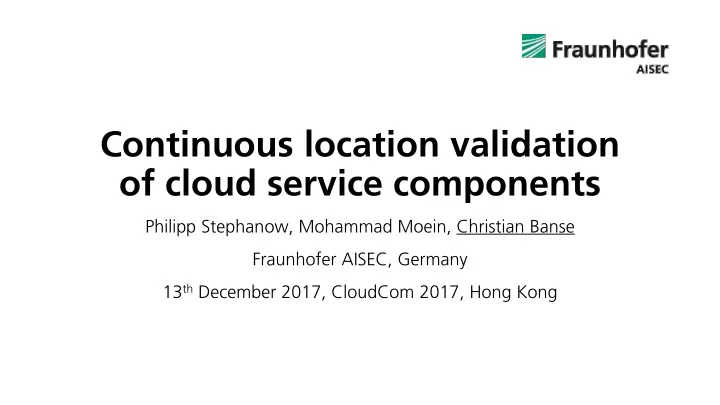

Continuous location validation of cloud service components Philipp Stephanow, Mohammad Moein, Christian Banse Fraunhofer AISEC, Germany 13 th December 2017, CloudCom 2017, Hong Kong
Introduction Who we are and what we do
The Authors Fraunhofer -Institute for A pplied and I ntegrated SEC urity Research institute solely focused on IT security (~ 100 employees) Located in Munich (main office) and Berlin Part of the Fraunhofer Society, biggest applied research organization in Europe (~ 20.000 employees) Philipp Stephanow , Senior Researcher in Cloud Service Certification Mohammad Moein , Student Researcher Christian Banse , Senior Researcher in Cloud and Network Security and Deputy Head of Department
Motivation Service or data location is regarded as one of the key decision criteria for companies in choosing cloud providers It is incorporated into many certificates and regulations, especially in Europe (BSI C5, EU GDPR, …) Depending on the service model, a change of location is not in the control of the customer Service location might not always be transparent, especially if using SaaS
Main Contributions Design of a process to classify geographical locations of virtual resources using Machine Learning (“location fingerprint”) Continuous execution of process including measures to counter the “concept drift” Experimental evaluation of the process and method using 14 locations of Amazon Web Services (AWS)
Adaptive Location Classification Designing the process
The process Goal: detect changes in a resource location Target: virtual resource with a (public) IPv4 address
Data Collection (Step 1) Internet layer • IPv4 traceroute ( path + delay of hops) • Measurement is executed multiple times; min , max , sd are recorded Transport layer • Delay between SYN and SYN-ACK of the TCP three-way handshake Application layer • Not in scope of this paper; however we working on it
Training (Step 2) Input is the feature vector collected in the first step An appropriate supervised learning algorithm needs to be selected, i.e. k-NN or SVM (Linear SVM works good) We can calculate the training error ε to adjust parameters of the data collection, i.e. number of measurements (10 is good) Output: prediction model
Detection (Steps 5 and 6) To classify locations at a latter stage • Collect samples again (same as in the first step) • Apply the training model to let the classifier classify a location We do not want to rely on a single classification because of training errors Solution: Consider a sequence of location detections within a time interval by introducing an invalidation window size 𝑥 𝑚− ≥ log 𝑤𝑚− log 𝜁 • Can be configured by a parameter 𝑤 𝑚 − • Depends on the training error ε
Updating (Steps 4, 7 and 8) After detection, we update the training model using the data fed into the classifier Before adding, we remove potential outliers using appropriate algorithms, i.e. one-class SVM Stop condition: We define a maximum training error after updating 𝜀 𝜁 , if the training error ε exceeds this, the process is stopped The new training error automatically configures the invalidation window size 𝑥 𝑚− (the higher the error, the larger the window)
Evaluation Trying it out…
Setup in AWS At the time of the experiment, 16 geographic regions in AWS 1 region = multiple availability zones (usually 2-3)
Setup in AWS 14 EC2 instances in 14 regions (excluding Beijing and AWS Gov Cloud) Instances with public IPv4 address with security groups that enable ICMP and SSH Origin of measurement was also in AWS, Frankfurt
Data Collection mtr to gather traceroute and nping to collect TCP delay (port 22) Experiment duration • 17th December 2016 – 23rd December 2016 • 15th December 2016 – 3rd January 2017 In total 139699 delay measurements
Training Implemented using scikit-learn using the LinearSVC classifier 10% of the data used as the training set 𝜁 = 0.0327 • Upper bound on the training error of • We tolerate training error after updating 𝜀 𝜁 < 0.35
Detection Remaining 90 % of the dataset are used as the test set Split up in 898 successive batches Each batch simulates the Collect new samples step of the process Location is predicted and compared to the expected value
Training error vs. window size Observed training error Invalidation window size
Result Test accuracy varies between 73.57 % and 100 % However, during the experiment, the invalidation window size was never exceeded As expected, no location change was observed during the experiment
Conclusions … and Future Work
Conclusions Introduction of an adaptive process to detect changes in the location of virtual resources Demonstration of feasibility by evaluating 14 AWS regions SVM classifier performed very well during evaluation (avg 92.96 %)
Limitations and Future Work We need to further study the affect of L2/L3 load balancers on the measurements Extend research from service location to data location Investigate performance of other classifiers, such as Random Forest Apply more sophisticated methods to detect concept drifts
Questions?
Recommend
More recommend